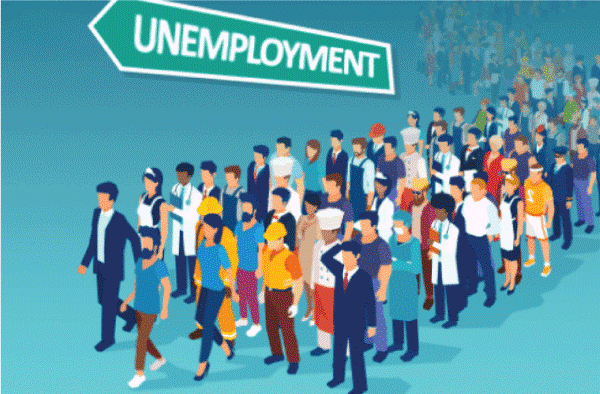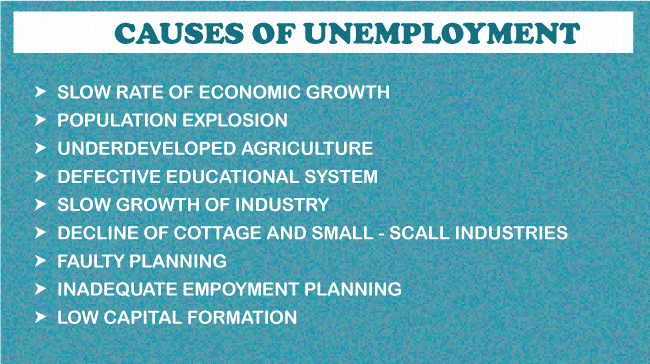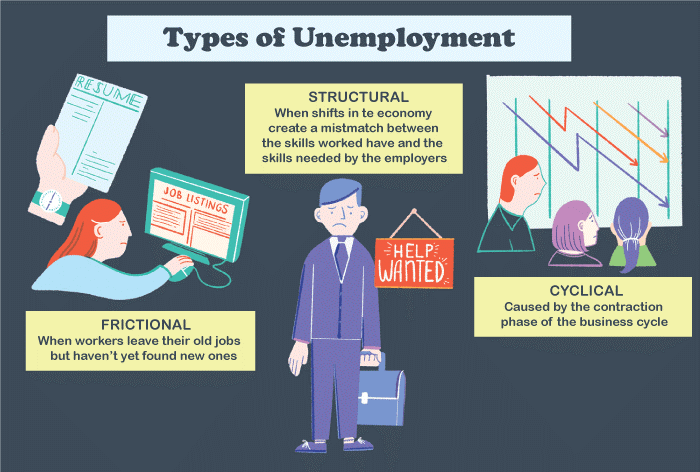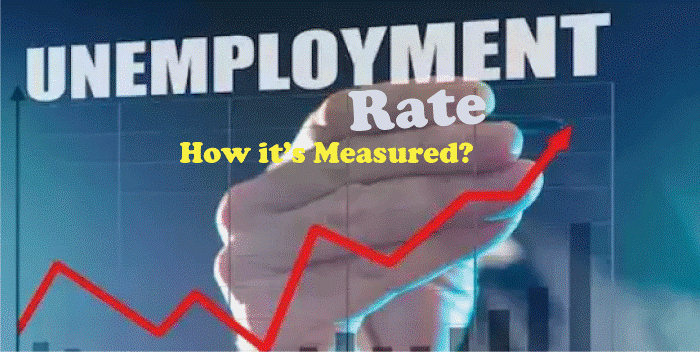Unemployment Definition
The term "unemployment" refers to the proportion of people available for work who cannot acquire it. Unemployment affects individuals, groups, areas, businesses, and the entire nation. Unemployment is one of the most critical indicators of a country's economic well-being. Usually, the unemployment rate is calculated by dividing the number of unemployed individuals by the total labour force. Individuals are said to be jobless if they are consistently searching for employment and cannot get a job. It only includes people who are still seeking work after being discharged and exempts those who have given up looking for work in the past four weeks for a variety of factors, such as retirement, disability, personal issues, or quitting a job to pursue higher learning, the term "Unemployment" is seen as having a negative association with it. Additionally, people who want to work but are not actively searching for a job are not included in the unemployment definition. The factors stated above can occasionally lead to misunderstanding and disagreement regarding whether the unemployment rate accurately reflects the absolute number of jobless individuals. It's fascinating that individuals who actively looked for employment within the previous 12 months but haven't searched for work in the last four weeks are classified as "marginally connected to the labour market." This categorization also includes a group of "discouraged employees" who have given up searching for employment. The Bureau of Labour Statistics (BLS) defines "employment" as people aged 16 and over who have recently put in hours of labour in working a minimum of one hour as a paid employee or their own company(trade, farm, or profession) whether paid or unpaid, because of self-employment. To understand the distinction between "unemployment" and "employment," a contrast is required. Key Takeaways
What Causes Unemployment?
On a global level, the slowdown in the country is the main factor contributing to unemployment. When the economy weakens, companies are forced to deduct labour costs. The COVID-19 epidemic increased jobless rates more than the 2007-2009 global depression. In reality, they were more comparable to the unemployment rates seen during the Great Recession during the first few months of the epidemic. The histories of recessions signify that rising jobless rates have always gone hand in hand with them. Additionally, competition within specific businesses or sectors can result in unemployment. Automation and other forms of advanced technology, such as computers, can result in job losses by taking jobs away from humans and giving them to robots. 1. The Evolution of the Caste SystemOne of the leading causes of unemployment in India is the caste system, a social division system that may affect nearly every part of life. In some places, people who belong to a specific tribe cannot perform certain jobs. This also has the effect of frequently favoring residents of a particular group over those with the necessary abilities and merit toward the position. 2. Insufficient Economic GrowthThe researchers anticipate that employment will increase as an economy's growth rate rises. The Indian economy is undeveloped, and economic development is not reaching its full potential. Due to the sluggish growth, there aren't enough employment opportunities for the expanding population. In other words, as the population grows, more and more people cannot find work because the industry cannot keep up with the demand for jobs. To solve the problem, there must be more employment obtainable on a global level. 3. Population DevelopmentIndia's population is anticipated to exceed China's by 2024, which will likely keep that distinction for the rest of the twenty-first century. A more significant percentage of the population is now unemployed due to the country's economy being unable to keep up with population growth. Due to the inability of the economy to keep up with population development, a higher proportion of the populace is now jobless. The fast-expanding population has changed the economy into one of low employment and widespread unemployment. 4. A Periodic Business(Agriculture)Agriculture employs a sizable percentage of the people, but only for a few months of the year. Consequently, many farm employees go for most of the year without a job or money. Agriculture isn't a glamorous industry. Deeply ingrained misconceptions plague it. Numerous economies are driven by agriculture. Agriculture could provide more quality employment and feed millions more people if it had the same financial and political backing as the other industry. 5. Organization for Small-Scale BusinessesCottage and small-scale businesses are no longer as fiscally appealing as they once were due to industrial development because they no longer offer the efficiencies of scale that come from large-scale mass manufacturing of products. The desire for goods handmade by people with specific abilities and knowledge frequently exceeds the demand for inexpensive, mass-produced goods. Consequently, the village and small-scale industries have drastically decreased, leading to an increase in unemployment among artisans (someone who creates things skilfully). 6. Poor Savings and Investment GainsSaving money is a personal virtue but a social sin. India consistently needs adequate money. Similar to how low funds are investments that rely on savings, it is also common. If spending rates were higher, more employees would have been generated, and the economy would have begun to grow. Savings has become less and less of a personal virtue in India as consumption rates rise and family savings rates decline. Furthermore, analysts point out that, despite the difficulty in obtaining accurate employment statistics, high unemployment rates are also responsible for declining financial savings. Additionally, there is a need for more investment in Tier 2 (cities with a population between 50,000 and 100,000) and Tier 3 towns (cities with a population between 20,000 and 50,000) and remote areas, which results in significant underutilized job potential. 7. Economic ShortageTroublingly, no national schemes account for the general unevenness between the supply of workers (plentiful) and the demand for workers (notably lower). For those who need employment to get it, there must be an equilibrium between the supply and demand of labour; otherwise, many people will fight for a single position. 8. Joint Family SystemIn large families with significant businesses, many unemployed people will rely solely on the family's combined revenue. It fosters disguised employment. Numerous people like this in huge families with significant business operations rely solely on the family's combined revenue for their daily needs. Rural communities have a higher percentage of joint families, contributing to the high level of covert unemployment there. Dependents on the family do not increase output. As a result, the earner of the family usually supports the "pretended jobless." 9. Labour InactivityAccording to their culture, maintaining close ties with their families is a top concern for many Indian residents. Consequently, individuals avoid moving far away from their relatives in search of work. Furthermore, the environment, language, and faith can all impact the workforce's effectiveness. As one might anticipate, unemployment increases when many people who are otherwise qualified for work cannot reach those positions. 10. Employment SpecialtyThe capitalist economy has led to a rise in highly specialized employment, but India's educational system needs to offer the proper preparation or specialization for these positions. As a result, many individuals who want to work but lack the necessary abilities can't find employment. 11. Absence of a Crucial SkillAccording to a survey, the absence of upcoming abilities keeps 33% of trained youth in India from finding employment. Even after completing their education, millions of individuals in our nation need more genuine experience and solid knowledge. The educated are not willing to take a chance and work for start-ups. Even though many are eager to go abroad for employment, they only desire government jobs in India; despite that, they can use their academic skills for a crucial role in companies; they prefer to throw away their 2 to 3 years in preparation for govt. Exams. Types of Unemployment
There are four categories of unemployment, including both voluntary and involuntary unemployment. 1. Frictional UnemploymentUsually, momentary unemployment falls under this category. Frictional unemployment is the duration between jobs during which a person looks for or changes positions. Depending on the conditions of the unemployed person, it is sometimes referred to as search unemployment and voluntary. Because jobs and employees are diversified, there might be a mismatch in supply and demand features, leading to frictional unemployment. Various things, including attitudes, compensation, job hours, geography, seasonal industries, and many other reasons, may cause such a clash. Both newcomers (like recently graduated students) and returning employees (like former stay-at-home mothers) may experience a period of frictional unemployment. It presents the fewest fiscal challenges. Finding new employment naturally requires some time after leaving a previous organization. Like recent graduates, those are just starting their job search contribute to the brief jobless. The fact is that the market processes require time and that knowledge can be expensive is an average outcome that leads to frictional unemployment. It takes time and effort to look for a new position, hire new employees, and connect the right employees with the right roles. Frictional unemployment is the consequence of this. This kind of unemployment typically occurs for a brief duration (less than one month). 2. Cyclical UnemploymentCyclical unemployment is the variation in the unemployment rate among the labour force during economic ups and downs, like those brought on by changes in the price of fuel. Unemployment rises during recessions and falls during periods of economic growth. One of the main goals of studying economics and the different government policy instruments to boost the economy during recessions is to prevent and reduce seasonal unemployment. With shifts in economic activity throughout the business cycle, cyclical unemployment happens. When there is a decline in the consumption of products and services, fewer positions are accessible for those who want to work. Companies facing lower demand may decrease their workforce by terminating current employees or recruiting fewer new ones. Consequently, it will be more difficult for those searching for jobs to obtain employment. When demand increases, the scenario is the exact opposite. Cyclical unemployment involves how it significantly rose in the early 1990s, declined to a low point near the beginning of the 2000s, and then rose once more during the global financial crisis. Cyclical unemployment is frequently described as being of the medium-term type (1 to 12 months). Increased cyclical unemployment could indicate the economy is not operating at its maximum potential. Businesses may give smaller salary raises due to the increased competition for employment, which would help to reduce inflation. With the help of actions that enhance total demand, such as an expanding monetary policy, this type of unemployment can be decreased (because businesses experiencing more robust demand are likely to employ more people). 3. Structural UnemploymentA technical shift in the economy's framework, where labour marketplaces are located, causes structural unemployment. The employees who are moved from positions that are no longer necessary due to technological change may become unemployed. Instances of such shifts include the mechanization of production and the substitution of horse-drawn transportation with cars. These employees may require challenging, expensive, and time-consuming retraining. Displaced workers frequently wind up either being out of work permanently or experiencing prolonged unemployment. Structural unemployment occurs when there is an imbalance between the number of positions available and the number of job seekers. This imbalance may exist because the available jobs are far away from the job searchers or because the available jobs require different abilities than the ones the job seekers possess. They might need help to obtain employment in another sector, so they might need to acquire new skills or relocate to an area with more possibilities. For instance, the percentage of people engaged in regular physical jobs has significantly decreased over the past few decades, with some jobs being mechanized due to technological advancements. The industrial sector is one illustration of an industry with a large proportion of repetitive physical work, and its contribution to the economy has shrunk (both in terms of production and employment). When compared to other kinds of unemployment, structural unemployment typically lasts longer. It may take employees several years to grow new abilities or relocate to a different area to find employment that fits their qualifications. Consequently, employees who experience long-term unemployment due to structural variables are more likely to do so (for over 12 months). Unlike cyclical unemployment, structural unemployment continues even when the market performs well. Theoretically, this kind of unemployment should not impact salaries or inflation, and it is best handled through policies emphasizing labour availability and skills. 4. Institutional UnemploymentInstitutional unemployment, as opposed to self-inflicted unemployment, happens when individuals are jobless due to societal and governmental factors and incentives. Any attempt to raise pay above the flexible rates, which in a free market tend to match the supply of each type of labour to its demand, illustrates this change. So-called "pro-labour" laws typically bring about the such barrier, but they may also be brought about by tradition, union action, or concern about violence. Long-term or institutional conditions and economic motivations cause institutional unemployment. The following components could contribute to widespread unemployment. Government policies include strict work licensing requirements, high minimum wage limits, and expensive social welfare programs. Employment discrimination and efficiency pay are examples of labour market occurrences. High unionization rates are an example of labour market organization. How to Compute Unemployment
One of the most widely used indicators for determining the condition of the labour market is the unemployment rate. Economic experts refer to the quantity of labour (from families) and demand for work as the "labour market" (by businesses and other organizations). The unemployment level is a crucial factor when considering monetary policy because it can offer more information about the economy. A person is declared jobless if they are available and capable of working but do not hold paid employment. The unemployment rate is the percentage of people without jobs in the workforce. So, to calculate the proportion of people who are presently jobless, it is essential to know who is working. The labour force comprises people who are either employed or unemployed. To decide who is employed or unemployed, it is necessary to make practical choices, such as how much compensated work someone must perform to be considered to have a job and to measure how many people have employment or not accurately. The Australian Bureau of Statistics (ABS) gathers details on the Australian labour market. Every month, the ABS conducts a poll known as the Employment Force Survey, which inquires about the labour market involvement of about 50,000 individuals. The working-age population, defined as those who are at least 15 years old, is divided into three main divisions as part of this survey: EmployedPeople who work an hour or more per week for pay are considered employed. Someone compensated for labour for an individual or business is called a laborer. Employees only need to be compensated by a company to be deemed employed; they do not need to work full-time for the person or business that pays them. UnemployedPeople actively seeking employment but not currently holding a salaried position are classified as unemployed. When someone is called "jobless," they are usually out of work and searching for employment. For instance, an individual who has resigned wouldn't be considered unemployed. Not In the Labour ForcePeople not working or searching for employment are considered outside the labour market. People outside the labour market who are neither working nor unemployed do not make up the labour supply. People who are employed assist those unemployed and are frequently viewed as dependents. And hence, for economic progress and development, people's involvement in the labour force is essential. It may involve people enrolled in school, offering to look after children or family members, retired, or those who can't work due to bodily limitations. Following the estimation of the population in each of these groups, the following labour market metrics can be computed as part of this survey: Labour ForceThe total number of individuals with jobs and without a job. All individuals who fulfil the requirements for participation among the working (regular jobs plus the military services) or the inactive build the labour force, also known as the "presently engaged population." Unemployed RateSeveral unemployed individuals are in the labour market. This entails the total number of jobless people ready to work and actively searching for employment and the total number of unemployed people willing to work but not actively looking for a job, which is a percentage of the total labour force. Participation RateThe percentage of people who are engaged in the working-age community. The percentage of the working-age population either employed or actively seeking employment is the labour force involvement rate. Because it reflects the proportion of labour resources that are readily accessible for the creation of products and services, this rate is a crucial factor in the labour market. The Formula for Calculating the Unemployment RateUnemployment rate= Unemployed / labor force*100 Note: Employed + unemployed = labour forceThe Formula for Calculating the Participation RateParticipation Rate= Labour force/working-age population*100 In general, labour force involvement follows the economic cycle. When companies hire more people and pay higher wages, people are more motivated to actively seek work. Contrarily, there is less of a reason for individuals to search for employment when companies are not recruiting and giving lower salary raises. Additionally, there are systemic factors that impact labour force involvement that is unrelated to the economic cycle. More possibilities for part-time employment, an increase in the number of women searching for work (greater female participation), and individuals working longer as they put off retirement are a few developments that have previously impacted the participation rate.
Next TopicEndemic Definition
|
 For Videos Join Our Youtube Channel: Join Now
For Videos Join Our Youtube Channel: Join Now
Feedback
- Send your Feedback to [email protected]
Help Others, Please Share










